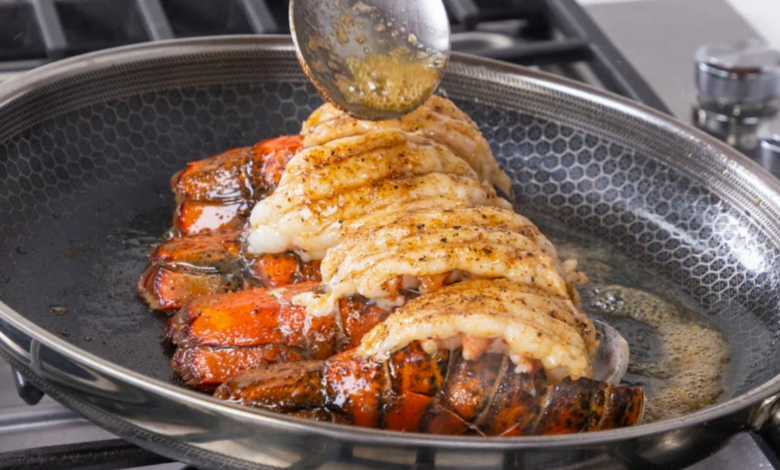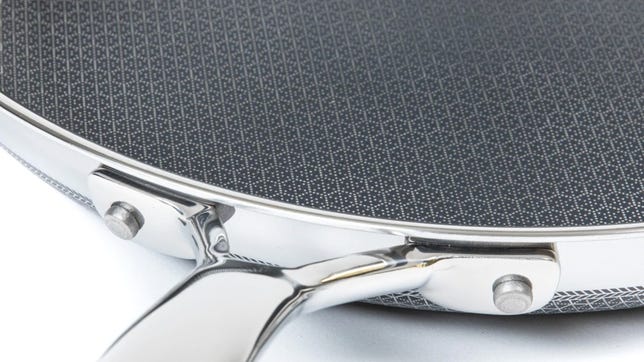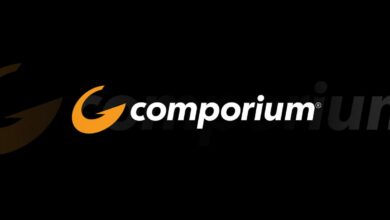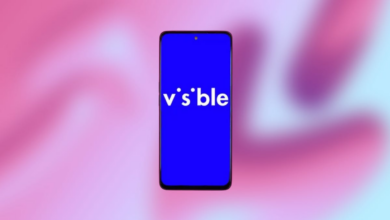HexClad Skillet Review: Can One Pan Sear Like Stainless Steel and Release Like Nonstick?



Basic material Magnetic steel
Weight (10 inches) 3 pounds
Cost (10 inches) $170
Sizes available 8, 10, 12, 14 inches
Positives
- Releases food almost as well as traditional nonstick cookware
- More durable than other non-stick cookware
- Resistant to metal utensils
- Heats evenly
Disadvantages
- Does not sear as well as stainless steel
- Heavier than other 10-inch pans
- Smudges easily
- Duration
You might be forgiven for thinking that HexClad cookware falls into one of the classic cookware categories. Although it has stainless steel running through it, it is not stainless steel cookware. It’s also not nonstick, although HexClad promises that the makeup’s proprietary material releases food as well as Teflon.
Nonstick stainless steel skillets are essential for most home cooks, myself included. HexClad has tried to create a single pan that gives you the best benefits of both nonstick and traditional pans. It features a non-stick coating for a smooth cooking experience while offering the durability and searing capabilities of stainless steel.
If these lofty claims are true, a HexClad skillet would be pretty much the only one you’ll ever need. To see how HexClad’s pricey pan compares to its marketing, I took a 10-inch skillet ($120) for a month-long test drive and cooked side-by-side with both stainless steel and nonstick pans.
While the HexClad didn’t perform exactly as advertised—it can’t sear as well as stainless steel—it does have clear advantages over other pans I tested. It won’t (and shouldn’t) replace all your cookware, but for the right person with the right cooking habits it would make a nice addition to your cookware collection.
This is my full review of HexClad’s 10-inch skillet.
What is HexClad cookware?
HexClad is the first cookware line to merge PFOA-free non-stick coating featuring stainless steel laser etched in an interwoven honeycomb pattern. The stainless steel lines are slightly raised, while the non-stick coating is placed in the center of the hexagonal honeycomb shapes. The idea is that the steel allows high surface heat when searing steaks, while protecting the non-stick coating from damage from metal utensils and general wear and tear.
Like most cookware, HexClad has an aluminum core that is both lightweight and an excellent heat conductor. But with 3 pounds, a HexClad 10-inch pan is still heavier than the average nonstick skillet or three-ply stainless steel skillet, most of which generally weigh less than 2 pounds.
HexClad makes one full line of cookwarebut i only have the frying pan – the most used piece. The sturdy frying pan has a comfortable, rounded, cool handle. It is both dishwasher safe and oven safe up to 500 degrees F.
The surface of the HexClad cookware is nonstick with laser-etched stainless steel for protection and extra surface heat. The idea is to offer the best of both.
HexClad vs. Stainless Steel
The big test for the HexClad as a replacement for stainless steel (or cast iron) is how well it can transfer surface heat and sear meat and vegetables. I cooked several seared dishes in the HexClad skillet, often alongside one All-Clad Three-Layer Stainless Steel Pan. The HexClad performed better than a traditional nonstick skillet, which isn’t great for searing, but it never reached the level of a good stainless steel pan.
In one test, I formed two round sausage patties and dropped them into both pans with a teaspoon of oil in each. I cooked them for two minutes on each side. As you can see in the image below, the stainless steel skillet produced a significantly better crust. This was the case with most of the high temperature searing I did with the HexClad pan.
The sausage cooked on the HexClad (left) did not develop a crust like the supplied All-Clad stainless steel pan (right).
HexClad vs. Nonstick
I’ve also cooked a variety of foods in the HexClad, which I would normally use a nonstick pan for. One of the most common nonstick candidates is scrambled eggs. If you’ve ever made eggs in a stainless steel pan, you know that there is usually some scrubbing involved, but the eggs should release completely from a good cleaning. non-stick coating Pan.
I cooked a scrambled egg in both the HexClad and a OXO frying pan with non-stick coating on low heat with a teaspoon of melted butter. This time the HexClad performed just as well as the nonstick skillet. The egg slid around easily once it set, then released completely when it finished cooking.
HexClad releases sticky food as well as any other nonstick pan.
Easier to clean than stainless
While the HexClad didn’t sear as well as stainless steel, it was much easier to clean, comparable to Teflon or nonstick. Just a warm water rinse and two wipes with a sponge made it spotless.
The HexClad (left) does not rinse clean as easily as Teflon, but is significantly easier to clean than stainless steel.
More durable than non-stick coating
Another big claim the HexClad makes is that it can withstand the wear and tear of utensils (even metal ones) that tend to damage a nonstick pan over time. In the month I used the HexClad, I didn’t notice any chips or visible damage to the protected nonstick coating. I even hit it a few times with a metal spatula, but the raised steel guards seemed to protect the more delicate nonstick material as intended.
Is Hexclad worth it?
HexClad was noticeably less adept at searing than the marketing jargon would lead you to believe. That said, it still sears meat, fish, and vegetables better than other nonstick pans. However, it is about the strongest nonstick pan you are likely to find. Nonstick frying pans have the shortest lifespan of any stovetop cookware. Even if you are careful to avoid metal utensils, the surface will inevitably chip and begin to lose its nonstick properties.
The HexClad even releases super sticky food as well as any nonstick pan, but it is remarkably strong and will likely last years longer than traditional nonstick pans. If nonstick is your material of choice for everyday cooking or if you are particularly rough with it, causing it to break easily, a HexClad will save you from having to replace the pan so often.
You can opt for a serial crepe or pancake maker HexClad’s 12-inch griddle ($140), because the breakfast food releases easily and you can use metal spatulas freely without fear of damaging the coating.




